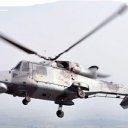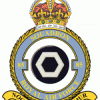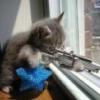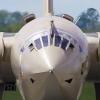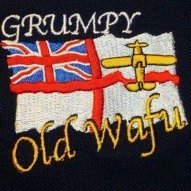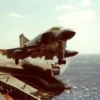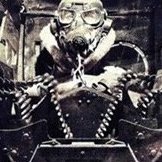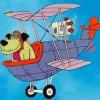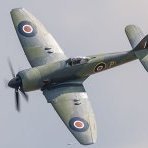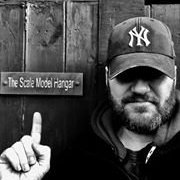Search the Community
Showing results for tags 'FAA'.
-
Finished the Corsairs, so let's move on to a couple of Martlets, using these Hobbyboss quickbuilds. Hopefully, shouldn't be too big a challenge as these kits go together really well. A little unrefined but something I can live with. They are fun to build so it should be good, and not too taxing which will be ok as I am a bit busy the next few weeks. Mor later.
-
Hifolks, I have another Tamiya corsair to make so I thought I would use it to do my first wip. The aircraft will be finished as JT371 of 1833 Sqn based on HMS Illustrious. The aircraft was flown by Lt N.Hanson on several occasions, notably during the attack on Sabang and Port Blair. The kit is well known but I will use the MDC conversion kit which comes with several resin parts for the cockpit, air scoops, prop and fuel tank. I aim to display it with wings folded and flaps up. I have added a few ignition wires to the engine. The flaps have had their attachment points cut off and require new ones to go through the existing holes but are shown here glued in. Here the flaps are up on the outer wings and the necessary cut has been made on both wingtips. I'll use some clear sprue to create the wingtip lights.
-
Chaps, Would anyone happen to know what grey the current Merlin HMA.2s are painted in FAA service? I am after a good acrylic spray-able paint in perhaps the Gunze/Mr Color or Tamiya ranges but want to make sure it's the right one. Cheers for any help. Andy
-
I'm going to record here my progress on a long-term triple build. It's quite likely that I'll deviate away from time to time to build something else (and I have a Sherman to build for the Great Patriotic War GB), so this may take a while to finish. I have always found De Havilland aircraft to be rather attractive designs, and their distinctive twin-boom jet designs also grabbed my attention when I was a kid. One of the first kits I bought as an adult was the Airfix 1/48 Sea Vixen. I realised when I got home just how big the finished article would be, and it entered the stash as "one for the future". Move on a few years and Airfix released their new tool 1/72 Vampire trainer. I resisted the kit as I didn't particularly like the included schemes and didn't find an aftermarket decal sheet justifiable, but Home Bargains' recent cheap sale of what I assume were Airfix overstocks meant that two kits entered my stash. Crisp's terrific and very educational Sea Vixen FAW.1 build (http://www.britmodeller.com/forums/index.php?/topic/234973210-de-havilland-sea-vixen-faw1-890nas-hms-ark-royal-1963-4/) was the final straw catalyst. No more excuses! But first, let's build something a bit smaller. You know, for twin boom practice... None of these are going to be completely OOB, but neither am I exactly going to town on the aftermarket. I'll be doing both Vampires in schemes from the Xtradecal overseas operators sheet #2. One will definitely be in the sand/brown Chilean camo scheme: The other I think will probably be in the Lebanese scheme, though I could easily be tempted by the Swiss and Aussie options on the sheet (or I may just wimp out at the prospect of the red and yellow bands required). I've picked up a couple of the Pavla ejection seats to go in that one; I suspect anything else in the cockpit will be invisible at this scale. Of course, they'll both be dwarfed by their big FAA sister. Again, she won't be OOB as I have some Eduard etch for the interior, and I've invested in a nice new pot of EDSG. Can't wait to brush paint all of that
-
Supermarine Seafire Mk.III "last Fights Over the Pacific" Special Hobby 1:48 It is believed that the Admiralty first showed an interest in a carrier based Spitfire as early as 1938, when Fairey Aviation proposed such a modification could take place. This idea was rejected and subsequently left the Fleet Air Arm to order other less capable aircraft. The matter was again raised in 1939 and a Spitfire was fitted with an A Frame arrestor hook. After further investigation folding wings were added to the specification. At the time one of the major factors holding back a Sea Spitfire (or Seafire as it was to become) was that production capacity was needed for land Spitfires. Due to this Wildcats were ordered from Grumman for the FAA to be called the Martlet. By the end of 1941 the Admiralty again looked at Spitfire project. 48 Spitfire Mk Vbs were converted by Air Training Services at Hamble to become hooked Spitfires. These would allow the Royal Navy to get experience operating the type, which due to its narrow undercarriage and high nose was not the ideal carrier aircraft. The second major type for the RN was the Seafire Mk II, this used a cropped supercharger to provide greater power at lower levels. The IIc was the first major mark to be deployed in any number. The Seafire Mk III was the real first true carrier Seafire. It was developed from the IIc. It had manually folding wings allowing more aircraft to be carried. The wing would fold using a system of two straight chordwise folds. A break was introduced immediately outboard of the wheel well where the wing would fold upwards and slightly forward, a second fold would be at the wingtip. The Mk III would use the Merlin 55 engine with a 4 bladed prop. The Mk III would be used by the Fleet Air Arm, The Irish Air Corps, and the French Aéronavale. The French would receive 65 Mk IIIs which were deployed to Vietnam on board the carrier Arromanches in 1948. The Irish Air Corps were supplied with 12 Mk III in 1947 which were stripped of their Naval equipment (except the wing fold) by Supermarine. The Kit The kit arrives in a fairly sturdy box. Inside are three large and three small sprues of grey plastic, a clear sprue, a sheet of vinyl, a sheet of photo etch; and an instrument panel film. Construction as with most aircraft starts with the cockpit area. The bulkhead forward of the pilot is made up along with the instrument panel. This is added to the engine firewall, the floor area including rudder pedals and control column is added. The seat can then be attached to its backing of armour plate, this along with the headrest is then added to the rear fuselage frame. PE seat belts and harness straps are then added. The next step is to add both of the previous subassemblies onto the main fuselage. Lage side panels with relief details are also added at this stage. The fuselage can then be closed up. The vinyl parts can then be applied to the closed up fuselage. The next stage in construction is the wings. The upper wing halves are attached to the one part lower wing. The internal sections of the wheel wells need to be placed inside the wing sections before they are closed up. The right cannon bulges need to be glued to the upper wing. There is no internal structure under the bulges. Be sure to use the right cannon bulges as there are four different sets on the sprues. The propellor is the next sub assembly to be built up, along with the arrestor hook parts If your build needs them). The next major task is to attach fuselage to the wings. Following this the tail planes, rudder, ailerons; and wing tips are added. Attention then turns to the underside of the aircraft. The radiators, engine under cowling, air intake and tail wheel are added. If your aircraft has an arrestor hook this sub assembly is also added, if not then a plate is added to this area. The undercarriage is also assembled and added at this stage. Finally to wrap up your build the engine exhausts, appropriate cannon barrels, aerial mast, entry door, propellor assembly; and canopies are added to the kit. Photo Etch & Vinyl A small photo etched fret is provided for the seat belts & harness, Instrument panel, rudder pedals, escape crowbar, and fuselage stiffening plates. A self adhesive vinyl sheet provides for raised areas on the fuselage where even PE would be too thick. An acetate film is provided for use between the PE instrument panel parts. Canopy The clear parts are very clear and remarkably thin. Care will need to be taken removing them from the sprue. I am not sure if the main canopy will fit over the rear part as the instructions do not show this. Decals Decals are provided for 3 aircraft. PR256, 894 Sqn HMS Indefatigable. April 1945. PR240, 880 Sqn HMS Improbable, June 1945. NN212, 887 Sqn HMS Indefatigable, August 1945. All decals are printed by Aviprint, are in register and colour density looks good. Conclusion A good re-release from Special Hobby showing aircraft from the last combat patrols of the FAA in the Far East. In fact NN212 took part int eh very last combat of the Fleet Air Air of WWII. Highly recommended. Review sample courtesy of
-
Good day again all! This is my first RFI for quite a while. This is a Special Hobby Sea Hawk depicted as WM 995 OF 802 NAS. I have built her as a Suez machine on board HMS Albion. This aircraft was actually hit by Egyptian ground fire which resulted in a damage to the stbd drop tank. The kit comes with a nice load of resin and one piece is a drop tank that depicts the damage, so I modelled her postflight, blanked up ready for a drop tank change. The kit was originally the MPM version with resin cockpit incorporating a front nose wheel well, seat and drop tanks, bombs and sidewinders for other versions. There is also a nice etch set but very little was used on this kit, just the IP. The only disappointment was no resin for the main gearbay. I wanted this to be a quick build but got hung up on a couple of things. I did have to open up the gun ports as the kit just had engravings but they turned out fine in the end. As ever finished in Model Master acrylics and kit decals which are a little transparent when placed over the fuselage stripes. Blanks are scratched from plastic card and wire handles, saved alot of effort in building up the intakes. Although black and white blurry pictures of the actual aircraft show a relatively clean fuselage I did muck up the area around the damaged tank. Any hoo enjoy!
- 11 replies
-
- 27
-

-
- Special hobby
- 1:72
-
(and 1 more)
Tagged with:
-
I was thinking about projects for the future and wondered what was the best (cheapest) way to get a 1/48 HC.4 Sea King. I have a Wessex HU.5 kit in stash and a Lynx HMA.8 with the backdate kit to make it an HAS.2. Was thinking a Falklands war Helicopter display would be quite satisfying. Would the Revell boxing of the SH-3H US Navy Sea King be a good starting point? Is there any resin available to make the changes to the landing gear? Has anyone got any plans to bring out a kit in the near future that I'm not aware of saving the whole expensive and messy business of 'making' an HC.4 from bits and bobs. Airfix scaling up their 1/72 Junglie would be awesome! Thanks. :-)
-
Hi, I joined this Group build and life got in the way so I missed the end unfortunately. Here is my completed Wessex HAS.1 which is built from the Italeri Kit. Please click on above link for build thread. Now before anyone spots it I'll confess and inacurracy... The MODEX number of 266 abbreviated to 66 on the nose is actually for HMS Hermes. But I wanted a OOB Wessex and also wanted a representation of the plane guard from the mighty Ark so this is close enough for me. Enjoy...
-
Hi folks, here is the AIrfix Harrier I was given. Dressed it up with some Pavla intakes, some scratch / scrap resin added to wheel bays and Pigsty gave me a seat. Build Thread... Enjoy.
-
Okay, I have not got the kit yet. I have lots to do at home as well as a 1/48 Phantom FG.1 and a 1/48 Sea Harrier to finish I have also a confession of shame that I bought the kit and never started it for the last rotary GB I joined which involved a Huey. However, given my 1/48 Phantom obsession, and my love of FAA subjects I am going to join this with the intended aim of producing a Plane Guard Wessex from Ark's Fleet. First helicopter since I was a kid, so no fancy bits, just as close as I can get to an OOB Wessex build. Any pointers on which kit and mods I need to make will be gratefully received! Thanks.
-
Great book, well written and lively. Maybe some errors or exclusions but a nice first hand account of Wessex Op's down south. Reccomended. I read it just after Sandy Woodward's 100 days. Made a nice pair.
-
Hi mates, You know, for a guy who has the audacity to call himself Navy Bird it's amazing that I didn't have a Sea Harrier in my collection. However, I had a couple of kits in the stash, so it was time to get to work. As this project progressed, it quickly became a kitbash between the Fujimi and Hasegawa Sea Harrier kits. Fujimi supplied the fuselage and wings, while Hasegawa provided the canopy, nose landing gear strut, tyres, Aden gun pods, Sidewinder missiles, anti-collision light, drop tanks, and miscellaneous sundries. I scratch built the intake blow-in doors, nose gear well, and the canopy detonator box. The aftermarket supplied a resin cockpit, resin outriggers, resin nozzles, turned metal pitot probe and AoA sensor, and a whole bunch of photoetch. Oddly, none of the aftermarket accessories were designed for either of the two kits. I also happened to still have a Microscale sheet from ages ago with the colourful markings of 800 Squadron prior to the Falklands conflict. I had to do that! Here is my executive summary: Project: Royal Navy Fleet Air Arm BAe Sea Harrier FRS.1 Kits: Fujimi (kit number F-30) and Hasegawa (kit number D19) Scale: 1:72 (please leave fumble thumbs at the door) Decals: Microscale Sheet 72-393, representing XZ454, No. 800 Squadron, 1980 Photoetch: Eduard 73384 (for Airfix), primarily for the cockpit, ejection seat details, detonator cord, mirror, antennae, windscreen wiper, landing gear doors, heat shields, vents Resin: Pavla cockpit C72092 (for Airfix), Pavla nozzles U72118 (for Airfix), Quickboost outriggers 72385 (for Airfix), Scale Resin 1,000 lb. bomb (from Buccaneer S.1 kit) Turned metal: Master AM-72-052 Vacuform: None! Joy in Mudville! Scratchbuilt: Intake blow-in doors, canopy detonator box, nose gear well, APU intake Paint: Gunze H333 Extra Dark Sea Grey, H331 Dark Sea Grey, H335 Medium Sea Grey, H417 RLM76, H11 Flat White, H12 Flat Black, H77 Tyre Black, H25 Sky Blue, H309 FS34079, H28 Metal Black, H95 Smoke Grey, H90 Clear Red, H94 Clear Green; Alclad 111 Magnesium, 314 Klear Kote Flat Weathering: Post shading with Gunze H95 Smoke Grey, some panel line work with pencil. Improvements/Corrections 1 - Shortened air brake 2 - Scratch built nose gear well, intake blow-in doors, APU intake, canopy detonator box 3 - All that aftermarket stuff Build thread: Link Pictures! FAA Family Reunion: Cheers, Bill
- 48 replies
-
- 74
-

-
Hi all! It could be said I have to many builds on, but dam it I want to build aircraft! Let's just hope I finish some. I currently have the hurricane GB to start and finish, the p47 GB to finish, the made in Britain GB to polish off really and possibly extend, and the corsair GB coming up soon Amongst all that I feel there is a bit of yanks with roundels theme on the go, so to continue that and as voted for at the end of my spitfire trio I will be building the Eduard hellcat. The kit is this Untitled by robert mulvey, on Flickr I was looking st the weekend edition due to cost, but managed to bag this one for £7 to my door... to much to miss really The kit its self is beautiful and one of the best kits I have seen in the box! It's also my first try at etch so should be a giggle for you all. I will be using the below transfer sheet Tech32015c by robert mulvey, on Flickr And will be using the lower scheme. It's actually almost a shame to not be using the one of the many transfer options that come with the kit but never mind....I will just have to buy more kits 😊 So I will be looking into the details of colours etc for these AC's in FAA service, mainly so I get internals like the CP wheel well etc the correct colour, for now and then plan to start work on this next week. Any info you have is always appreciated! Oh and just another big thank you to the kind chap that sent the transfer sheet, Mr P, I hope the lady and baby are well and cheers again Rob
- 112 replies
-
- 10
-

-
Hi, did anyone ever produce a model kit of the Hiller HT-2 training helicopter, or is it a case of "If you want it, scratch it?" I know Special Hobby produced a 1/72 kit that could be used for an HT-1. Cheers
-
Barracuda Mk. II "Home Fleet" 1:72 Special Hobby The Fairey Barracuda was an all-metal torpedo/dive bomber, designed to replace its Fairey stablemates, the Swordfish and the Albacore. Although vastly more modern than the aforementioned aircraft, the ungainly Barracuda had a mixed service career. It achieved some fame for the part it played in the successful attack on the German battleship Tirpitz in April 1944, but when deployed to the Pacific theatre, the high temperatures and high altitude requirement were not a good match for the Barracuda's abilities. Despite the fact that in excess of 2500 Barracudas rolled off the production line by the end of the War, none survive intact today. The Fleet Air Arm Museum in Yeovilton is, however, slowly rebuilding an example from recovered wreckage, so there is hope for fans of this rather interesting aircraft. This is Special Hobby's second attempt at the Barracuda. Their first was a traditional, short-run injection moulded kit initially released in 1999 under the MPM label. Although that was a massive improvement over the old FROG kit, the world of scale modelling has moved on since then. Happily, Special Hobby have moved with the times, to the point that they are now able to offer a completely new kit produced from all-metal moulds. As you might expect, the new kit is a quantum leap over its predecessor, both in terms of detail and overall quality. Apart from three sprues of nicely moulded grey plastic, the box also contains a single clear sprue and a decal sheet with marking options for two aircraft. Construction starts with a reasonably well detailed cockpit. This sub-assembly is effectively split into two main parts. The forward cockpit includes a pilot's seat in three parts, a floor pan, side consoles, rear bulkhead and control column. An instrument panel and rudder pedals are also included. The rear cockpit includes the other two crew seats, radio kit and other details. The inside of the fuselage halves also feature some sidewall detail. The overall effect is a pleasingly detailed cockpit, which is just as well given the large canopy that is a characteristic of their aircraft. The only improvement I could suggest would be the addition of a set of photo etched harnesses, if you happen to have some available. Before the fuselage halves can be joined, the shackle for the torpedo must be fitted to the belly of the aircraft. The fuselage side windows are fitted from the outside, so there should be no danger of them popping out of the frame and rattling around inside the fuselage. Construction of the wing is fairly conventional. The wing itself is split into upper and lower halves, between which are sandwiched the walls of the main landing gear bays. These might be slightly fiddly to fit, but the level of moulded detail should mean they look terrific once finished. The light in the leading edge of the port wing must also be fitted at this point. Ailerons are moulded in place, but the Barracuda's distinctive dive brake flaps are separate parts, as are the wingtip formation lights. The horizontal stabiliser has the elevators moulded in place, and rudder is moulded as part of the vertical stabiliser. The Barracuda's ungainly landing gear is quite nice and each wheel is split vertically. The distinction between wheel and tyre could be clearer, but with careful painting they should look fine. The airscrew is moulded in six parts, which each of the four blades moulded separately. You will need to take care when assembling this part in order to make sure that everything lines up properly. The canopy is moulded as a single solid part. The canopy is thin and clear but the frame lines could be a little crisper. Ordnance comes in the form of a large torpedo and a single bomb. Bombe racks for the underside of the outer wings are also included. The outer wing locking plungers and radar antennas are both present and correct. The exhaust parts can be fitted from the outside, which means they can be painted separately and then added at the end of the build. Two decal options are provided: Barracuda Mk.II LS556 (or LS550) of 829 Naval Air Squadron, HMS Victorious, May 1944. This was one of the aircraft that successfully hit the Tirpitz during Operation Tungsten. Barracuda Mk.II BV937 of 830 Naval Air Squadron, HMS Furious, 1944. This aircraft also took part in Operation Tungsten. Both aircraft are finished in Extra Dark Sea Grey and Dark Slate Grey over Sky. The decals themselves look great on the sheet and a full set of stencils is provided too. Conclusion It's great to have a brand new tool of this important (if not especially attractive) aircraft. The overall shape looks ok, while the quality of moulding, treatment of surface detail and the rendering of parts such as the cockpit are all very good indeed. Overall, this is a really nice kit which is already tempting me to build it, if I can find the time. Highly recommended. Review sample courtesy of
-
Hi all, I have a question concerning a project I am working on. I plan to build the Tamiya 1/32 F4U-1A Corsair as a Royal Navy craft, and have been collecting items for a while. I have decided to paint as many markings as possible and to this end have purchased the "MonteX" super mask set # K32333. the masks and paint guide show standard (I believe) far east markings of a blue and white tail flash, and blue and white roundels on the fuselage. But the wing roundels are as follows: Outer ring of Blue then a red ring, and finally an inner spot of white. Is this correct? as I dont think I have ever noticed this arrangement before. Any help would gratefully received. Ian
-
-
- 1
-

-
- Helicopter
- FAA
-
(and 1 more)
Tagged with:
-
Right-oh. Having a bit of fun, (of course modelling is always fun) but got given this kit and fancied jazzing it up without too much expense or hassle. 1983 Airfix Sea Harrier. Bought a eduard etch set for the Kinetic kit and some Pavla intakes. An aero-club white metal seat kindly donated by Pigsty. So I set forth, first step. Drill out the camera port and polish up a bit of clear sprue. Then looked at my references and noticed that the nose gear doors and airbrake are open on the ground. So the kit needed some detail adding. I have a set of F-4J electronic bays of which I only plan to use one of for a forthcoming Phantom build... Guess what? They are the same width as a Harrier nose gear door. The bad news is it does not leave enough room to put the gear in, but it at least looks more 'aircrafty' inside.
-
A bit of info from the chaps at Eduard before I post a few pics. During Operation ‘Hoops’, Lt. Blythe Ritchie of 800 Sqd, gained a kill over an Fw 190 A from JG 5. It was his fifth kill, his first in the cockpit of a Hellcat, and consequently, one of the few kills by the Hellcat over the Luftwaffe. Six days later, during Operation ‘Potluck A’, Ritchie gained another aerial victory flying JV132. He attacked a formation of He 115 floatplanes, and got an individual kill, and one more shared with Lt.Cdr. Stan Ohrr. So I purchased yet another Eduard kit recently and cracked on with the dual combo Mk1 and Mk2 Hellcat (FAA) This is the completed Mk1, and I am happy with how it turned out, much better than my previous FW190. Paints used were Tamiya acrylics followed by Humbrol's gloss cote, decalfix used on the carto decals (Which were very nice i must say) and then finished off with Humbrol's matt cote. The wing nav lights are clear enamel colours as i find that works much better than the tamiya acrylic ones when using clearfix to attach. No wash was placed onto this aircraft but exhaust stains were tamiya's smoke and oils for the rust/dirt stain. Now I'm onto the Mk2 Hellcat! And one of the cockpit before sealing the sides... Feedback welcome as I'd love to hear what people think!
- 12 replies
-
- 11
-

-
Hello I am searching infos about the Fulmar mk. I (N4004) of 800X Squadron, shot down by Italian anti-aircraft fire, off Siracusa (Sicily) on the night of October, 8, 1941. The wreck lies on a sandy bottom at about 15 meters depth. I would like to build this aircraft in 1/72 and I need info mainly regarding camouflage pattern and individual code. Thank you for your help Domenico
-
Hi, There is a lot of knowledge about the Spey Phantom on this site, some of it from people who actually worked on them in service. I thought I would start this thread to pick people's brains and allow others to learn a bit too. To kick off I'm keen to learn more about dummy Sparrows... I have read that the Spey Phantoms carried dummy Sparrows in the forward bays: "...as fuel was used, in fact the F-4K/M became dangerously close to having a C of G problem in certain conditions" The thing is I cannot seem to find any pictures of early FG.1 with them, and frequently these aircraft in RN service have empty bays. Was it only really an issue later, or with the RAF preferring wing tanks. Was this partly off set by the FAA preference for the centre tank. Was this why the RN preferred the centre tank. (Did they even or is that another dubious fact?) I am having to collate info from various sources to jump to these scanty assumptions and if someone hands on would like to correct me I would be delighted. Not just from a modelling point of view (no Spey Phantom will ever have a C of G problem now sadly) but more to improve my knowledge of what is rapidly becoming my favourite aircraft. Thanks.
-
So after a long-ish break from the hobby i finished my first model in A year . This is the Eduard Hellcat MKII from the FAA dual combo set. I built the first one last may and started this one a few weeks later, but it got to the printshop and then stalled. after getting back into the hobby i wanted to do a easy build to ease myself back in, and this was perfect as it was almost finished! i primed it, and did pre shading (my first ever time). i then painted it Humbrol 25 with an airbrush, but sadly when painting the white stripes i got some overspray on the model which made the pre shading less visible and also made some parts a lighter colour than others. i kept having issues with lumps of pigment from the white paint blocking the nozzle so ended up brush painting the stripes. also, during the recalling i knocked over my micro sol onto several decals so some of them broke up and wrinkled . This is the first time i have ever airbrushed a model and overall i am pretty happy with it. On another note, how do you stop micro-sol and micro-set staining the paint? Will
-
Hello! I wonder if any of you can help me? I'm building a FAA Avenger III from the 1/48 TBM-3D Accuate Miniatures kit. I thought it would be quite straightforward and then I read somewhere that the FAA aircraft had an addition seat directly behind the pilots position..........After I've fitted the fuselage together. I've had a nosy around on the search engines and I can find one or two builds with the seat in place, but I can't get a good view of it. If any of you have a decent photo of the seat and how its fixed would you be kind enough to share it with me? At the moment I have scratched a new seat and I want to see if I can retro fit it into the interior without too much bother. I may need to rip out the US radios? I'm not bothered about having the model absolutely accurate, but I would like to see if I can make a decent Mk.III all the same. Thanks for your help!
-
Hi all, In the process of building up a stash of FAA jets in 1:72 and noticed that Model Alliance have the ML48121 decal set for many of these types, for the Ark Royal air wing. It looks like an interesting project, but as it all hangs on these decals being correct, I just wanted to check that there were no errors with the set that anyone was aware of? Thanks for any advice, Tony
- 7 replies
-
- Model alliance
- decals
-
(and 2 more)
Tagged with:
-
Hi, Another archive model - from a deep past. Fairey Firefly FR I in markings of 1770 Sq FAA based on HMS Indefatigable, Pacific fleet, spring 1945. I made it i 1993, so many years before much nicer SH kit appeared. As usually I was trying to do small improvment to the kit. Some are perhaps still visible. Now - before posting I had to change roundels and lettering - the original were bad quality did not stand time. The present are taken from Techmod sets (for FAA Wildat and a white lettering). Comments welcome and regards Jerzy-Wojtek
- 13 replies
-
- 19
-

-
- Fairey Firefly
- FAA
-
(and 1 more)
Tagged with:

